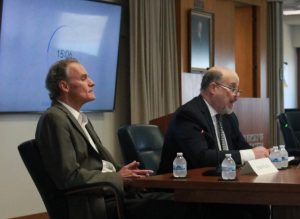The Students for a Free Tibet talk the pillars of control in modern Tibet
October 15, 2014
On Tuesday, Oct. 7, the Students for a Free Tibet organization at UW-La Crosse hosted a presentation in the Centennial Hall of Nations featuring political freedom activist, Tenzin Dolkar, who spoke on the issue of repression for the citizens living in Tibet today. She is also the executive director of the Students for a Free Tibet (SFT) organization.
Her presentation touched on many aspects of the Tibetan revolution, including the origin of the Tibetan resistance, China’s attempts to diminish international political support for Tibet and the Dalai Lama, the resistance itself and how it is constantly evolving and how everyday people in the United States can make a huge impact on the resistance and take necessary action to free Tibet from the vice of China’s rule.
China invaded and took hold of Tibet in 1949, and the Tibetans have been resisting their rule ever since. As of recently, China has imposed a blackout upon Tibet, meaning that no one on the outside can find out what exactly is happening inside of Tibet. Since the beginning of the resistance, a total of 132 Tibetans have self-immolated, a term used to describe the lighting of oneself on fire as a form of protest.
Dolkar emphasized three main reasons why Tibetans are willing to go to such extremes to have their voices heard. She identified “Three Pillars of Control from China,” explaining why Tibetans have reacted in the ways that they have in the past.
Dolkar questioned, “What is it that keeps Tibet between such a rock and a hard place that they feel their only option is to perform such drastic measures?”
She identified the first pillar of control from China as “military occupation.” Since 1949, when China first invaded Tibet with tanks and guns, there has been military personnel at every cross-street and intersection with their guns pointed every which way. In addition, the majority of China’s military spending goes towards maintaining their grip on Tibet.
The second pillar she identified was China’s “colonial rule.” For five generations now, China has had control over Tibet and its citizens.
“…Five generations of being told that they’re useless, that they’re uncivilized, that they’re uneducated, backwards, and dirty,” Dolkar said.
Tibetans have been rid of their native identities. About two thirds of the Tibetan population have been forced to relocate off of their grasslands into ghetto-type housing. They have been forced to abandon their native language and writing system because they are told it is useless.
The third and last pillar of control that she identified was “fear and intimidation.” Dolkar described this pillar more generally as just the sense of fear that is instilled into the Tibetan citizens by the military personnel and more broadly, the Chinese government collectively, to keep them from further resistance. However, as the world has seen, especially through the wave of self-immolations, Tibet is not backing down until they are liberated.
Dolkar’s presentation and personal insight provided a very introspective viewpoint regarding the state of Tibet and the Tibetan resistance and revolution today. She reminded the UW-L community about the importance of aiding Tibet in their freedom now and for years to come.





